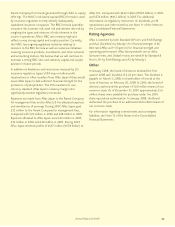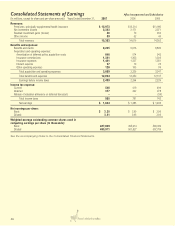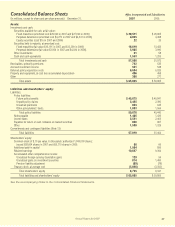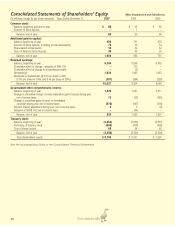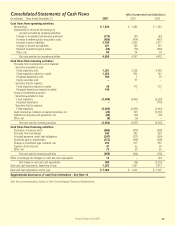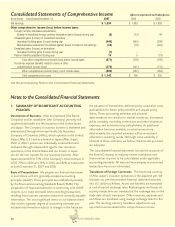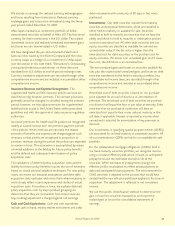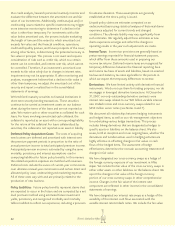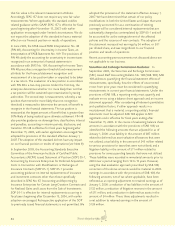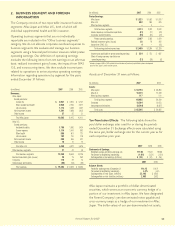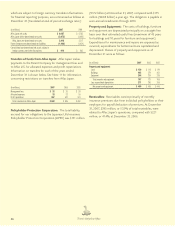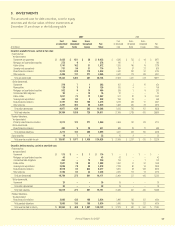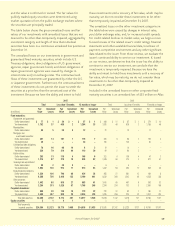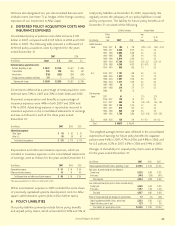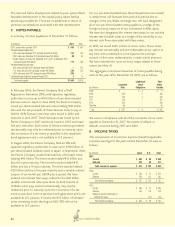Aflac 2007 Annual Report Download - page 58
Download and view the complete annual report
Please find page 58 of the 2007 Aflac annual report below. You can navigate through the pages in the report by either clicking on the pages listed below, or by using the keyword search tool below to find specific information within the annual report.
54 There’s Only One Aflac
that fair value is the relevant measurement attribute.
Accordingly, SFAS 157 does not require any new fair value
measurements. Where applicable, this standard codifies
related guidance within GAAP. SFAS 157 is effective for fiscal
years beginning after November 15, 2007, with earlier
application encouraged under limited circumstances. We do
not expect the adoption of this standard to have a material
effect on our financial position or results of operations.
In June 2006, the FASB issued FASB Interpretation No. 48
(FIN 48), Accounting for Uncertainty in Income Taxes, an
Interpretation of FASB Statement No. 109. The provisions of
FIN 48 clarify the accounting for uncertainty in income taxes
recognized in an enterprise’s financial statements in
accordance with SFAS No. 109, Accounting for Income Taxes.
FIN 48 prescribes a recognition threshold and measurement
attribute for the financial statement recognition and
measurement of a tax position taken or expected to be taken
in a tax return. The evaluation of a tax position in accordance
with FIN 48 is a two-step process. Under the first step, the
enterprise determines whether it is more likely than not that
a tax position will be sustained upon examination by taxing
authorities. The second step is measurement, whereby a tax
position that meets the more-likely-than-not recognition
threshold is measured to determine the amount of benefit to
recognize in the financial statements. The tax position is
measured at the largest amount of benefit that is greater than
50% likely of being realized upon ultimate settlement. FIN 48
also provides guidance on derecognition, classification, interest
and penalties, accounting in interim periods, disclosure, and
transition. FIN 48 is effective for fiscal years beginning after
December 15, 2006, with earlier application encouraged. We
adopted the provisions of this standard effective January 1,
2007. The adoption of this standard did not have any impact
on our financial position or results of operations (see Note 8).
In September 2005, the Accounting Standards Executive
Committee of the American Institute of Certified Public
Accountants (AICPA) issued Statement of Position (SOP) 05-1,
Accounting by Insurance Enterprises for Deferred Acquisition
Costs in Connection with Modifications or Exchanges of
Insurance Contracts (SOP 05-1). SOP 05-1 provides
accounting guidance on internal replacements of insurance
and investment contracts other than those specifically
described in SFAS No. 97, Accounting and Reporting by
Insurance Enterprises for Certain Long-Duration Contracts and
for Realized Gains and Losses from the Sale of Investments.
SOP 05-1 is effective for internal replacements occurring in
fiscal years beginning after December 15, 2006, with earlier
adoption encouraged. Retrospective application of this SOP
to previously issued financial statements is not permitted. We
adopted the provisions of this statement effective January 1,
2007. We have determined that certain of our policy
modifications in both the United States and Japan that were
previously accounted for as a continuation of existing
coverage will be considered internal replacements that are
substantially changed as contemplated by SOP 05-1 and will
be accounted for as the extinguishment of the affected
policies and the issuance of new contracts. The adoption of
this statement increased net earnings by $6 million, or $.01
per diluted share, and was insignificant to our financial
position and results of operations.
Recent accounting pronouncements not discussed above are
not applicable to our business.
Securities and Exchange Commission Guidance: In
September 2006, the Securities and Exchange Commission
(SEC) issued Staff Accounting Bulletin No. 108 (SAB 108). SAB
108 addresses quantifying the financial statement effects of
misstatements, specifically, how the effects of uncorrected
errors from prior years must be considered in quantifying
misstatements in current year financial statements. Under the
provisions of SAB 108, a reporting entity must quantify and
evaluate errors using a balance sheet approach and an income
statement approach. After considering all relevant quantitative
and qualitative factors, if either approach results in a
misstatement that is material, a reporting entity’s financial
statements must be adjusted. SAB 108 applies to SEC
registrants and is effective for fiscal years ending after
November 15, 2006. In the course of evaluating balance sheet
amounts in accordance with the provisions of SAB 108, we
identified the following amounts that we adjusted for as of
January 1, 2006: a tax liability in the amount of $87 million
related to deferred tax asset valuation allowances that were
not utilized; a tax liability in the amount of $45 million related
to various provisions for taxes that were not utilized; and a
litigation liability in the amount of $11 million related to
provisions for various pending lawsuits that were not utilized.
These liabilities were recorded in immaterial amounts prior to
2004 over a period ranging from 10 to 15 years. However,
using the dual evaluation approach prescribed by SAB 108,
correction of the above amounts would be material to 2006
earnings. In accordance with the provisions of SAB 108, the
following amounts, net of tax where applicable, have been
reflected as an opening adjustment to retained earnings as of
January 1, 2006: a reduction of tax liabilities in the amount of
$132 million; a reduction of litigation reserves in the amount
of $11 million; and a reduction in deferred tax assets in the
amount of $4 million. These three adjustments resulted in
a net addition to retained earnings in the amount of
$139 million.



